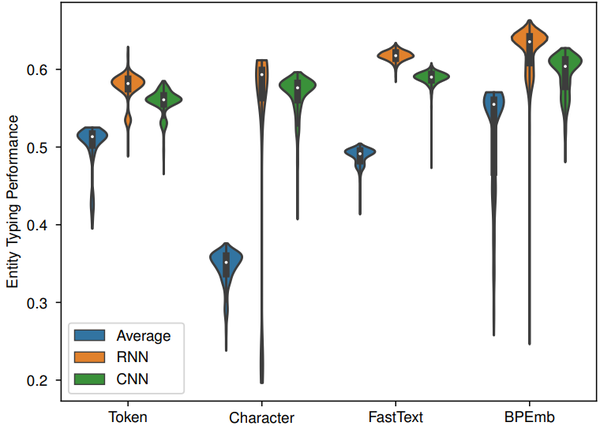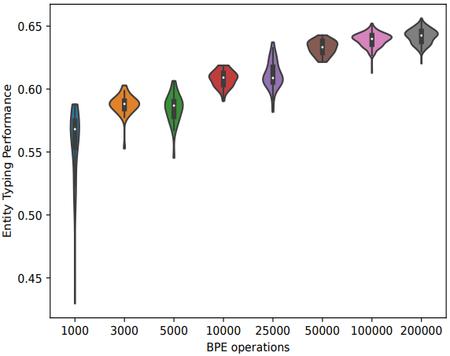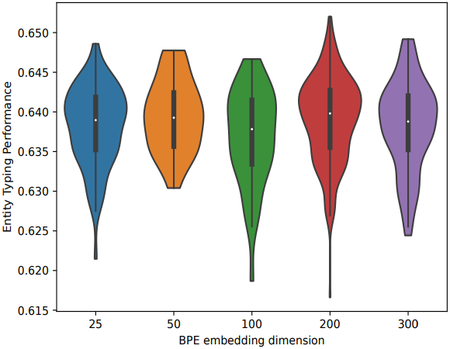2018 BPEmbTokenizationFreePreTrained
- (Heinzerling & Strube, 2018) ⇒ Benjamin Heinzerling, and Michael Strube. (2018). “BPEmb: Tokenization-free Pre-trained Subword Embeddings in 275 Languages.” In: Proceedings of the Eleventh International Conference on Language Resources and Evaluation (LREC 2018).
Subject Headings: BPEmb, Subword Unit Embedding.
Notes
- The paper present pre-trained subword unit embeddings for multiple languages. They compare them other embedding approaches which such as FastText, Glove, and Word2vec.
- The text is tokenized using Byte Pair Encoding algorithms with different merge operations (vocabulary sizes) 1000, 3000, 5000, 10000, 25000, 50000, 100000, and 200000. The output is used to train Glove Embeddings with different dimensions 25, 50, 100, 200, and 300.
- The different models were evaluated using fine-grained entity typing task which is assumed to have many rare, and long-tail entities. Such entities are not expected to have good representations in common Embedding approaches.
- The results of experiments show that the BPEmb performance is comparable and sometimes better than the performance of common embedding approaches such as FastText for multiple languages.
- Online Resource(s)
- Other Version(s):
- (Heinzerling & Strube, 2017) ⇒ Benjamin Heinzerling, and Michael Strube. (2017). “BPEmb: Tokenization-free Pre-trained Subword Embeddings in 275 Languages.” In: arXiv preprint arXiv:1710.02187.
Cited By
- Google Scholar: ~ 112 Citations.
- Semantic Scholar: ~ 6 Citations.
- MS Academic: ~ 5 Citations
Quotes
Author Keywords
Abstract
We present BPEmb, a collection of pre-trained subword unit embeddings in 275 languages, based on Byte-Pair Encoding (BPE).
In an evaluation using fine-grained entity typing as testbed, BPEmb performs competitively, and for some languages better than alternative subword approaches, while requiring vastly fewer resources and no tokenization.
BPEmb is available at https://github.com/bheinzerling/bpemb.
1. Introduction
Learning good representations of rare words or words not seen during training at all is a difficult challenge in natural language processing. As a makeshift solution, systems have typically replaced such words with a generic UNK token. Recently, based on the assumption that a word's meaning can be reconstructed from its parts, several subword-based methods have been proposed to deal with the unknown word problem: character-based recurrent neural networks (RNN) (Luong and Manning, 2016), character-based convolutional neural networks (CNN) (Chiu and Nichols, 2016), word embeddings enriched with subword information (FastText) (Bojanowski et al., 2017), and byte-pair encoding (BPE) (Sennrich et al., 2016), among others. While pre-trained FastText embeddings are publicly available, embeddings for BPE units are commonly trained on a per-task basis (e.g. a specific language pair for machine translation) and not published for general use.
In this work we present BPEmb, a collection of pre-trained subword embeddings in 275 languages, and make the following contributions:
- We publish BPEmb, a collection of pre-trained byte-pair embeddings in 275 languages;
- We show the utility of BPEmb in a fine-grained entity typing task; and
- We show that BPEmb performs as well as, and for some languages better than, alternative approaches while being more compact and requiring no tokenization.
2. BPEmb: Byte-pair Embeddings
Byte Pair Encoding is a variable-length encoding that views text as a sequence of symbols and iteratively merges the most frequent symbol pair into a new symbol. E.g., encoding an English text might consist of first merging the most frequent symbol pair t h into a new symbol th, then merging the pair th e into the in the next iteration, and so on. The number of merge operations $o$ determines if the resulting encoding mostly creates short character sequences (e.g. to = 1000$) or if it includes symbols for many frequently occurring words, e.g. $o = 30,000$ (cf. Table 1). Since the BPE algorithm works with any sequence of symbols, it requires no preprocessing and can be applied to untokenized text.
| Merge ops | Byte-pair encoded text |
|---|---|
| 5000 | 豊 田 駅 (と よ だ え き ) は 、 東京都 日 野 市 豊 田 四 丁目 にある |
| 10000 | 豊 田 駅 (と よ だ えき ) は 、 東京都 日 野市 豊 田 四 丁目にある |
| 25000 | 豊 田駅 (とよ だ えき ) は 、 東京都 日 野市 豊田 四 丁目にある |
| 50000 | 豊 田駅 (とよ だ えき ) は 、 東京都 日 野市 豊田 四丁目にある |
| Tokenized | 豊田 駅 ( と よ だ え き ) は 、 東京 都 日野 市 豊田 四 丁目 に ある |
| 10000 | 豐 田 站 是 東 日本 旅 客 鐵 道 (JR 東 日本 ) 中央 本 線 的 鐵路 車站 |
| 25000 | 豐田 站是 東日本旅客鐵道 (JR 東日本 ) 中央 本 線的鐵路車站 |
| 50000 | 豐田 站是 東日本旅客鐵道 (JR 東日本 ) 中央 本線的鐵路車站 |
| Tokenized | 豐田站 是 東日本 旅客 鐵道 ( JR 東日本 ) 中央本線 的 鐵路車站 |
| 1000 | to y od a _station is _a _r ail way _station _on _the _ch ūō _main _l ine |
| 3000 | to y od a _station _is _a _railway _station _on _the _ch ūō _main _line |
| 10000 | toy oda _station _is _a _railway _station _on _the _ch ō _main _line |
| 50000 | toy oda _station _is _a _railway _station _on _th-e chūō _main _line |
| 100000 | toy oda _station _is _a _railway _station _on _the chūō _main _line |
| Tokenized | toyoda station is a railway station on the chūō main line |
We apply BPE[1] to all Wikipedias [2] of sufficient size with various o and pre-train embeddings for the resulting BPE symbol using GloVe (Pennington et al., 2014), resulting in byte-pair embeddings for 275 languages. To allow studying the effect the number of BPE merge operations and of the embedding dimensionality, we provide embeddings for 1000, 3000, 5000, 10000, 25000, 50000, 100000 and 200000 merge operations, with dimensions 25, 50, 100, 200, and 300.
3. Evaluation: Comparison to FastText and Character Embeddings
To evaluate the quality of BPEemb we compare to FastText, a state-of-the-art approach that combines embeddings of tokens and subword units, as well as to character embeddings.
FastText enriches word embeddings with subword information by additionally learning embeddings for character n-grams. A word is then represented as the sum of its associated character n-gram embeddings. In practice, representations of unknown word are obtained by adding the embeddings of their constituting character 3- to 6-grams. We use the pre-trained embeddings provided by the authors.[3]
Character embeddings
In this setting, mentions are represented as sequence of the character unigrams[4] they consist of. During training, character embeddings are learned for the $k$ most frequent characters.
Fine-grained entity typing
Following Schutze (2017) and Yaghoobzadeh and Schutze (2017), we use fine-grained entity typing as test bed for comparing subword approaches. This is an interesting task for subword evaluation, since many rare, long-tail entities do not have good representations in common token-based pre-trained embeddings such as word2vec or GloVe. Subword-based models are a promising approach to this task, since morphology often reveals the semantic category of unknown words: The suffix -shire in Melfordshire indicates a location or city, and the suffix -osis in Myxomatosis a sickness. Subword methods aim to allow this kind of inference by learning representations of subword units (henceforth: SUs) such as character ngrams, morphemes, or byte pairs.
Method
Given an entity mention $m$ such as Melfordshire, our task is to assign one or more of the 89 fine-grained entity types proposed by Gillick et al. (2014), in this case /location and /location/city. To do so, we first obtain a subword representation
$s = SU\left(m\right) \in R^{l\times d}$
by applying one of the above SU transformations resulting in a SU sequence of length $l$ and then looking up the corresponding SU embeddings with dimensionality $d$. Next, $s$ is encoded into a one-dimensional vector representation
$v = A\left(s\right) \in R^d$
by an encoder $A$. In this work the encoder architecture is either averaging across the SU sequence, an LSTM, or a CNN. Finally, the prediction $y$ is:
$y =\dfrac{1}{1 + \exp\left(−v\right)}$
Data
We obtain entity mentions from Wikidata (Vrandecic and Krotzsch, 2014) and their entity types by mapping to Freebase (Bollacker et al., 2008), resulting in 3.4 million English[5] instances like (Melfordshire:/location,/location/city). Train and test set are random subsamples of size 80,000 and 20,000 or a proportionally smaller split for smaller Wikipedias. In addition to English, we report results for a) the five languages having the largest Wikipedias as measured by textual content; b) Chinese and Japanese, i.e. two high-resource languages without tokenization markers; and c) eight medium- to low-resource Asian languages.
Experimental Setup
We evaluate entity typing performance with the average of strict, loose micro, and loose macro precision (Ling and Weld, 2012). For each combination of SU and encoding architecture, we perform a Tree-structured Parzen Estimator hyper-parameter search (Bergstra et al., 2011) with at least 1000 hyper-parameter search trials (English, at least 50 trials for other languages) and report score distributions (Reimers and Gurevych, 2017). See Table 2 for hyper-parameter ranges.
| Unit | Hyper-parameter | Space |
|---|---|---|
| Token | embedding type | GloVe, word2vec |
| Character | vocabulary size | 50, 100, 200, 500, 1000 |
| embedding dimension | 10, 25, 50, 75, 100 | |
| FastText | − | − |
| BPE | merge operations | 1k, 3k, 5k, 10k, 25k |
| 50k, 10k, 200k | ||
| embedding dimension | 25, 50, 100, 200, 300 | |
| Architecture | Hyper-parameter | Space |
| RNN | hidden units | 100, 300, 500, 700, |
| 1000, 1500, 2000 | ||
| layers | 1, 2, 3 | |
| RNN dropout | 0.0, 0.1, 0.2, 0.3, 0.4, 0.5 | |
| output dropout | 0.0, 0.1, 0.2, 0.3, 0.4, 0.5 | |
| CNN | filter sizes | (2), (2, 3), (2, 3, 4), |
| (2, 3, 4, 5), (2, 3, 4, 5, 6), | ||
| (3), (3, 4), (3, 4, 5), (3, 4, 5, 6), | ||
| (4), (4, 5), (4, 5, 6), (5), (5, 6), (6) | ||
| number of filters | 25, 50, 100, 200, | |
| 300, 400, 500, 600, 700 | ||
| output dropout | 0.0, 0.1, 0.2, 0.3, 0.4, 0.5 | |
| Average | output dropout | 0.0, 0.1, 0.2, 0.3, 0.4, 0.5 |
4. Results and Discussion
4.1. Subwords vs. Characters vs. Tokens
Figure 1 shows our main result for English: score distributions of 1000+ trials for each SU and architecture. Token-based results using two sets of pre-trained embeddings (Mikolov et al., 2013; Pennington et al., 2014) are included for comparison.

|
Subword units
BPEmb outperforms all other subword units across all architectures (BPE-RNN mean score $0.624 \pm 0.029$, max. $0.65$). FastText performs slightly worse (FastText-RNN mean $0.617 \pm 0.007$, max. $0.63$)[6], even though the FastText vocabulary is much larger than the set of BPE symbols.
BPEmb performs well with low embedding dimensionality Figure 2, right) and can match FastText with a fraction of its memory footprint (6 GB for FastText's 3 million embeddings with dimension 300 vs 11 MB for 100k BPE embeddings (Figure 2, left) with dimension 25.). As both FastText and BPEmb were trained on the same corpus (namely, Wikipedia), these results suggest that, for English, the compact BPE representation strikes a better balance between learning embeddings for more frequent words and relying on compositionality of subwords for less frequent ones.

|

|
FastText performance shows the lowest variance, i.e., it robustly yields good results across many different hyperparameter settings. In contrast, BPEmb and character-based models show higher variance, i.e., they require more careful hyper-parameter tuning to achieve good results.
Architectures
Averaging a mention's associated embeddings is the worst architecture choice. This is expected for character-based models, but somewhat surprising for token-based models, given the fact that averaging is a common method for representing mentions in tasks such as entity typing (Shimaoka et al., 2017) or coreference resolution (Clark and Manning, 2016). RNNs perform slightly better than CNNs, at the cost of much longer training time.
4.2. Multilingual Analysis
Table 3 compares FastText and BPEmb across various languages. For high-resource languages (top) both approaches perform equally, with the exception of BPEmb giving a significant improvement for English. For high resources languages without explicit tokenization (middle), byte-pair encoding appears to yield a subword segmentation which gives performance comparable to the results obtained when using FastText with pre-tokenized text[7].
| Language | FastText | BPEmb | ∆ |
|---|---|---|---|
| English | 62.9 | 65.4 | 2.5 |
| German | 65.5 | 66.2 | 0.7 |
| Russian | 71.2 | 70.7 | -0.5 |
| French | 64.5 | 63.9 | -0.6 |
| Spanish | 66.6 | 66.5 | -0.1 |
| Chinese | 71.0 | 72.0 | 1.0 |
| Japanese | 62.3 | 61.4 | -0.9 |
| Tibetan | 37.9 | 41.4 | 3.5 |
| Burmese | 65.0 | 64.6 | -0.4 |
| Vietnamese | 81.0 | 81.0 | 0.0 |
| Khmer | 61.5 | 52.6 | -8.9 |
| Thai | 63.5 | 63.8 | 0.3 |
| Lao | 44.9 | 47.0 | 2.1 |
| Malay | 75.9 | 76.3 | 0.4 |
| Tagalog | 63.4 | 62.6 | -1.2 |
Results are more varied for mi- to low-resource Asian languages (bottom), with small BPEmb gains for Tibetan and Lao. The large performance degradation for Khmer appears to be due to inconsistencies in the handling of unicode control characters between different software libraries used in our experiments and have a disproportionate effect due to the small size of the Khmer Wikipedia.
5. Limitations
Due to limited computational resources, our evaluation was performed only for a few of the 275 languages provided by BPEemb. While our experimental setup allows a fair comparison between FastText and BPEmb through extensive hyper-parameter search, it is somewhat artificial, since it disregards context. For example, Myxomatosis in the phrase Radiohead played Myxomatosis has the entity type /other/music, which can be inferred from the contextual music group and the predicate plays, but this ignored in our specific setting. How our results transfer to other tasks requires further study.
6. Replicability
All data used in this work is freely and publicly available. BPEmb and code to replicate our experiments is available at https://github.com/bheinzerling/bpemb.
7. Conclusions
We presented BPEmb, a collection of subword embeddings trained on Wikipedias in 275 languages. Our evaluation showed that BPEmb performs as well as, and for some languages, better than other subword-based approaches. BPEmb requires no tokenization and is orders of magnitudes smaller than alternative embeddings, enabling potential use under resource constraints, e.g. on mobile devices.
Acknowledgments
This work has been supported by the German Research Foundation as part of the Research Training Group “Adaptive Preparation of Information from Heterogeneous Sources” (AIPHES) under grant No. GRK 1994/1, and partially funded by the Klaus Tschira Foundation, Heidelberg, Germany.
Footnotes
- ↑ We use the SentencePiece BPE implementation: https://github.com/google/sentencepiece.
- ↑ We extract text from Wikipedia articles with WikiExtract (http://attardi.github.io/wikiextractor), lowercase all characters where applicable and map all digits to zero.
- ↑ https://github.com/facebookresearch/
- ↑ We also studied character bigrams and trigrams. Results were similar to unigrams and are omitted for space.
- ↑ Numbers for other languages omitted for space.
- ↑ Difference to BPEmb significant, $p < 0.001$, Approximate Randomization Test.
- ↑ Tokenization for Chinese was performed with Stanford CoreNLP (Manning et al., 2014) and for Japanese with Kuromoji (https://github.com/atilika/kuromoji).
References
BibTeX
@inproceedings{2018_BPEmbTokenizationFreePreTrained,
author = {Benjamin Heinzerling and
Michael Strube},
editor = {Nicoletta Calzolari and
Khalid Choukri and
Christopher Cieri and
Thierry Declerck and
Sara Goggi and
Koiti Hasida and
Hitoshi Isahara and
Bente Maegaard and
Joseph Mariani and
Helene Mazo and
Asuncion Moreno and
Jan Odijk and
Stelios Piperidis and
Takenobu Tokunaga},
title = {BPEmb: Tokenization-free Pre-trained Subword Embeddings in 275 Languages},
booktitle = {Proceedings of the Eleventh International Conference on Language Resources
and Evaluation (LREC 2018)},
publisher = {European Language Resources Association (ELRA)},
year = {2018},
url = {http://www.lrec-conf.org/proceedings/lrec2018/summaries/1049.html},
}
| Author | volume | Date Value | title | type | journal | titleUrl | doi | note | year | |
|---|---|---|---|---|---|---|---|---|---|---|
| 2018 BPEmbTokenizationFreePreTrained | Michael Strube Benjamin Heinzerling | BPEmb: Tokenization-free Pre-trained Subword Embeddings in 275 Languages | 2018 |